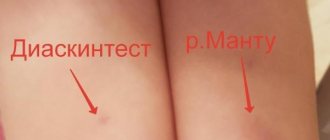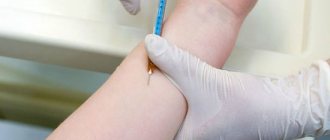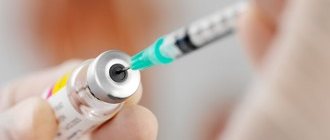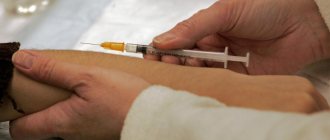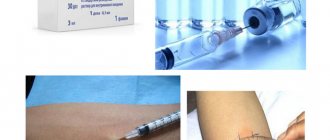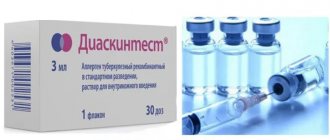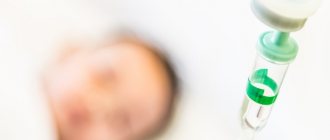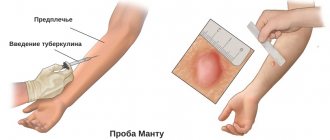Is it possible to do it at the same time?
According to the order of the Russian Ministry of Health dated December 29, 2014, number 951, tuberculin diagnostics can be more extensive. Mantoux and Diaskintest are done on the same day.
This is not prohibited, but the main condition is to administer vaccines on different hands. What is it and what is their difference?
Mantoux is an injection that is injected into the skin. It contains killed mycobacteria of the disease. Diaskintest is also an injection that is done intradermally, but contains only antigen proteins.
With the first method, a false positive result is present in cases where the body has had contact with other infections or people with tuberculosis. Diaskintest gives positive results only when the child is already infected or has tuberculosis. There is a difference; for reliability, two manipulations are performed at once.
Simultaneous manipulations place a significant burden on the immune system. Before you decide to do this, you should weigh the pros and cons.
Reasons for joint holding
Why is the Mantoux test and Diaskintest done at the same time? Since these two diagnostic procedures differ in their effect, outcome indicators will provide the opportunity to obtain more accurate information.
Such an examination is advisable if the parents are sure that the child was in contact with a tuberculosis patient. The sample and test can detect pathology even at an early stage. An active form of tuberculosis can also be detected.
If the father and mother cannot decide what to choose, in this case (in the absence of contraindications and the presence of strong immunity), the doctor may advise doing both.
Information about tuberculosis and the need for tests
Tuberculosis is a socially dangerous disease caused by mycobacteria bovine or human tuberculosis, as well as many other strains. It most often affects the respiratory system, but can also affect other body systems.
It is transmitted by all known routes, the main method being airborne droplets. Which causes high epidemiological risks.
The disease is widespread in all regions. Mycobacterium tuberculosis is highly resistant to external conditions and has the ability to transform, developing resistance to drugs.
The prevention of tuberculosis in children is given special importance. This is determined by age-related weakness of the immune system, the mobility of children, attempts to taste everything, lack of hygiene, and frequent walks.
95% of people are infected with Koch's wand, but not everyone gets sick. Mycobacteria can remain in a latent form for a long time. And only after some time, under the influence of negative factors, it becomes activated. The main reason is weakened immunity.
This can be caused by:
- poor nutrition;
- illness;
- difficult working or living conditions;
- addictions;
- climate change.
There are several forms of the disease. The active open form is dangerous for others and the infected person. This is what is detected using injection tests - the Mantoux test and Diaskintest.
Tuberculosis is highly curable in the early stages (on average within six months). But the specificity of the pathology is that it is not always possible to suspect it in the early stages. It may take years for the first symptoms to appear.
The first symptoms include:
- deterioration of health;
- cough;
- persistent low-grade fever;
- chest pain;
- night sweats;
- weight loss.
As the disease progresses, they will intensify and progress. Without treatment, there is a high risk of death for humans and an epidemiological outbreak for the region.
Diagnostic tests are an important element of prevention. However, their passage is voluntary. Until the age of 18, parents decide for their children; from 18, citizens decide for themselves. The adult population should undergo annual fluorography instead of injections.
Without a fluorographic health report in the patient’s hands, he will not be provided with medical care (except in emergency cases). Upon initial contact with the registry, a person is redirected to X-ray diagnostics. Parents of children must provide a similar conclusion when enrolling them in school or kindergarten.
Prevention of tuberculosis begins from the first days of a person’s life. A couple of days after birth, the child is given a BCG vaccination, which will help develop immunity to tuberculosis.
Its maximum validity period is seven years. Diagnostic injection tests allow not only to identify the disease, but also to monitor the state of immunity and select a group for BCG revaccination.
Mantoux and Diaskintest are not vaccines or vaccinations. This is an immunity test. Introduction of an allergen into the body in order to assess the immune response to it. According to phthisiatricians, procedures cannot replace each other, their purpose is to complement.
Content
Evaluation of results
As mentioned above, manipulations are performed on different hands. Three days later, the specialist evaluates the results and draws appropriate conclusions, taking into account Mantoux and Diaskintest. It is important to adhere to all post-vaccination rules so that the information is truthful. If the child wets the injection site, you need to tell the doctor about it.
A specialist always evaluates the size of the papule. Depending on this, a verdict is made.
Mantoux is positive and Diaskitest is negative
If the Mantoux is positive and the Diaskintest is negative, it means that the child has immunity after BCG. It is also assumed that there is MBC in the body, but they do not differ in their activity. To verify and clarify the result, it is advisable to re-test after a certain time. If parents do not want to wait, they seek advice from a TB specialist, who in turn prescribes additional diagnostics. If a disease is detected, treatment must begin.
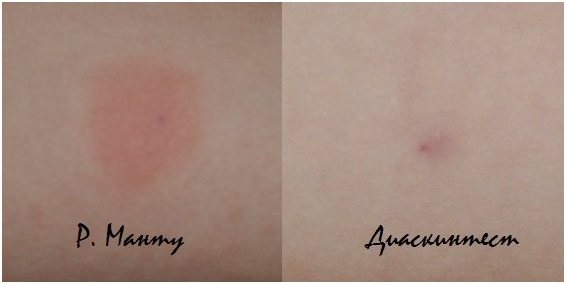
There is also a variant of positive Mantoux - contact of the corresponding hand with water. It is important not to wet or treat the injection site with any antiseptic. If any actions were performed, the doctor will not be able to reliably assess how the body reacts to the vaccine.
With a negative Diaskintest, tuberculosis is rarely detected in humans, since this is a fairly reliable and effective diagnostic method.
Mantoux is negative and Diaskitest is positive
If the Mantoux reaction is negative, and the Diaskintest gave a positive result, the information here can be assessed in the same way as in the situation described above.
Most often, this manifestation indicates the presence of Koch's bacillus in the body. To confirm this, other diagnostic procedures are done. If the body is not infected, then there should be nothing on the hand where Diaskintest was done, since the antigen protein does not react to anything other than mycobacteria.

Mantoux positive and Diaskitest positive
There is undoubtedly an infection with the tuberculosis bacillus. Positive reactions on both hands are a reason to start immediate treatment. You must first visit a phthisiatrician and undergo other diagnostic measures. The latter usually determine the degree of infection and the form of tuberculosis.

If the condition is extremely serious, hospitalization cannot be avoided. Only health workers are able to provide all the necessary assistance to the patient. After this, the patient is usually transferred to outpatient treatment, where he continues to take the prescribed medications. In the future, you should plan a sanatorium-resort treatment that will consolidate the result and prevent the disease from worsening.
Mantoux negative and Diaskintest negative
If there are no papules and redness on the hands, this indicates negative results of both Mantoux and Diaskintest. This reaction indicates that the person has not had contact with mycobacteria, and there is no need to worry about anything. No further examination is required.

Next time, it is not recommended to do simultaneous diagnostics, as this is a lot of stress for the body.
The injection site may change due to other factors that have nothing to do with tuberculosis infection, these are:
- Allergic reaction to the components of the drug. In this case, swelling, rashes, ulcers, extensive hyperemia appear, and even body temperature rises. In severe cases, breathing difficulties are observed. To prevent the occurrence of anaphylactic shock and other equally dangerous manifestations, you should immediately go to the hospital. If the doctor sees something similar on the arm, this means that the child is contraindicated for further examination for tuberculosis in this way.
- Failure to comply with the rules in the post-vaccination period. Papule and redness sometimes occur if the hand is wet or treated with alcohol solutions, ointments or gels. Contact with any product is strictly prohibited. This can lead not only to a false positive result, but to various consequences.
- Incorrect administration of the drug. If the manipulation was carried out by an unqualified specialist, then a false result may also appear. To avoid such an excess, you must first make sure that the nurse has enough experience in performing such injections (if, of course, such a possibility exists).
- Carrying out tests and samples during a respiratory illness or an exacerbated chronic disease. If the child was not examined beforehand, or the doctor did not pay attention to the fact that he was sick, the immune system may not cope with the drug and react to it in all possible ways, not in favor of the patient. Naturally, after this, the current disease will take much longer to heal and the test itself will be false. As a result, you will have to re-diagnose.
In any case, only a doctor can decipher the result of one or another test.
Carrying out procedures and evaluating samples
Carrying out diagnostics and evaluating results in both cases are similar. Before starting the diagnosis, the doctor studies the children’s medical records and examines them (the child must be absolutely healthy). Parents are notified of scheduled testing in advance. Written consent is taken from them.
The child’s legal representatives have the right to a written refusal to undergo injection diagnostics. But, according to another law, they are required to provide a different way to test for tuberculosis infection.
The procedure takes place in a medical office in compliance with sanitary and hygienic standards. The health worker must wear a gown, gloves and a mask. The tested child takes a sitting position. The specialist should explain the specifics of the injection and further care of the puncture site.
The injection site is treated with alcohol before the procedure and with a dry, clean disc after. The injection (2 TU) is administered strictly subcutaneously at an angle into the inner middle part of the forearm. A disposable special syringe is used.
A papule is formed at the site of injection of the substance, the size of which is assessed after three days. Its meaning is the result, which is interpreted according to the generally accepted classification.
The procedures have a number of contraindications, safety measures and care recommendations. They are identical.
Contraindications include:
- the child’s illness at the time of the procedure (exacerbation of chronic pathologies, colds, somatic diseases, viruses, etc.);
- a cold suffered less than a month ago (specifically how long after a particular illness can be carried out by injection diagnostics of tuberculosis can be found out from a pediatrician or in a medical reference book);
- an allergic reaction to the drug, chronic at the time of exacerbation or an allergy of unknown etymology;
- quarantine in a child care facility and 30 days after it;
- epilepsy;
- immune deficiency and other pathologies;
- violation of the integrity of the skin at the injection site;
- administration of any vaccination on the day of diagnosis or a month before it;
- expired shelf life of the drug, its improper storage or transportation;
- taking any medications.
Pediatricians and TB specialists agree that the selection of the period of medical withdrawal and the decision on the admissibility of diagnostics should be made based on the specific case and the general medical history of the child. For example, for a child who is often sick, it is better to wait a month or two after a common cold. For another child, two weeks is enough.
You can do a tuberculin test or diaskintest in state educational institutions (kindergarten, school), in children's and adult hospitals at the place of registration, at work, in private clinics and medical centers, in a tuberculosis dispensary. Paid and free diagnostics are possible. Some organizations practice having a health worker visit your home.
For three days after administration of the substance, the injection site must not:
- rub;
- irritate in any way mechanically or chemically;
- make one sweat;
- bandage, seal;
- apply creams (peroxide, iodine, brilliant green);
- avoid contact with detergent, perfume, chlorine (when swimming in pools), dirt;
- expose to ultraviolet light.
It is not recommended to take allergenic foods, foods with unknown reactions, or alcohol before the procedure and until the results are assessed. Both individual intolerance and general risks should be taken into account. For example, children have allergens such as nuts and chocolate.
You can shower and walk, but with caution. Almost all security measures are aimed, first of all, at preventing an erroneous result. To avoid, as a result, a number of additional procedures, visits to hospitals and TB specialists.
The result is assessed using a transparent ruler with millimeter divisions. The expected reaction is visible after just six hours. Only the size of the papule and its density (infiltrate) are taken into account. If the “button” is not visible, then the hyperemia (redness) around is examined.
Several results are possible:
- Positive (infected). The papule is noticeable (from 0.5 cm). Three degrees of severity are possible. The first (weak) - 0.5-0.9 cm, the second (medium) - 1-1.4 cm, pronounced - 1.5-1.6 cm.
- Negative (does not have tuberculosis). The papule is absent or barely noticeable, there is no redness.
- Doubtful. There is no papule, but hyperemia is pronounced (0.2-0.4 cm).
- Hyperergic. The infiltrate is more than 1.5 cm. Around it, skin deformations may be observed in the form of erosions, ulcers, suppuration, inflammation, and rashes.
- Turn. Enlargement of the papule relative to the result of the previous diagnosis.
False positive and false negative results also occur. The first is not uncommon for Mantoux, and the second for Diaskintest. False results can be caused by violation of the procedure technique and failure to comply with contraindications.
In each case, in addition to a negative reaction, additional tests are prescribed (another injection immediately (two weeks later), a repeat primary procedure after two months, x-rays, fluorography, blood tests, and others). A diagnosis is never made based on the results of one method. Sometimes two tests are performed at once - Mantoux and Diaskintest (necessarily on different hands).
Depending on the complex result, a person can be taken under the supervision of a TB specialist, subject to preventive chemotherapy, and referred to outpatient or inpatient therapy. If an infection is detected, he must be hospitalized, his place of residence is called an outbreak, he is treated, and his immediate environment is diagnosed.
Conclusion
Is it possible to do Manta and Diaskintest at the same time? In some cases, manipulations are carried out simultaneously. Such a decision should be deliberate, as this is a strong burden on the baby’s immunity. The two procedures differ in their action; together they can more accurately determine whether a person is infected or not.
If parents cannot choose which of the two examination methods is better or they are sure that their child was in close contact with an infected person, then Mantoux and Diaskintest are allowed to be carried out at the same time. If there is no need to rush, then Manta is done first, and then, after 14-21 days, Diaskintest. In this case, there is time to restore immunity after the first vaccination.
The results are assessed by a doctor after three days. It is important that the patient follows all the rules so that a false positive or false negative reaction does not occur. In different situations, other further actions are taken. If necessary (if both tests or only one are positive), additional diagnostics are recommended to rule out the presence of tubercle bacilli in the body. In case of unexpected wetness of the injection site, a repeat test is done after a certain period of time.
